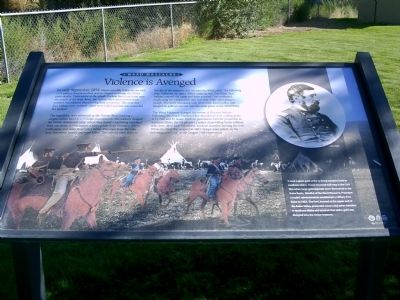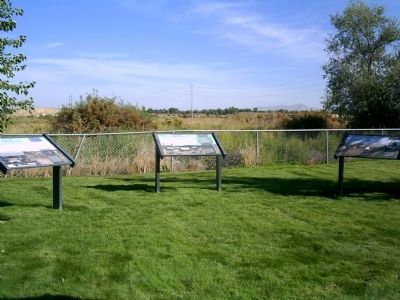Near Middleton in Canyon County, Idaho — The American West (Mountains)
Violence is Avenged
Ward Massacre
The expedition next advanced up the Payette River tracking a suspect Indian band to a 15-lodge encampment. The soldiers charged the hastily-abandoned camp where they found a saddlebag inscribed with one of the victims names, a silver goblet from Germany, $50 in a silk purse, and other Ward party items. Two men from the tribe were discovered nearby and were killed. The military then went to the site of the massacre and reburied the Ward party. The following year, Hallar set out again. While camping near Fort Boise, four Indians entered the camp and were arrested. One confessed, implicating his companions, and was shot while attempting to escape. The three remaining men were tried, found guilty, and hanged on gallows erected over the mass grave of the Ward party.
The Ward Massacre changed the course of Western history. Following the attack, Hudson's Bay abandoned their trading posts at Ft. Hall and Ft. Boise. With no permanent forts for protection in southern Idaho, the US adopted a policy of providing horse soldiers, who were often local volunteers, to escort travelers braving the trail. When the Civil War erupted in 1861, troops were pulled. In the following years, use of the Oregon Trail plummeted.
It took a giant gold strike to bring travelers back to southern Idaho. Travel resumed mid-way in the Civil War when large gold deposits were discovered in the Boise Basin. Mindful of the Ward Massacre, President Lincoln's administration established a military Fort Boise in 1863. The Fort, located at the upper end of the Boise Valley, protected miners and other travelers in southern Idaho and assured that Idaho gold was directed into the Union treasury.
Topics and series. This historical marker is listed in these topic lists: Native Americans • Notable Events • Settlements & Settlers • War, US Civil. In addition, it is included in the Former U.S. Presidents: #16 Abraham Lincoln series list. A significant historical year for this entry is 1854.
Location. 43° 40.633′ N, 116° 36.532′ W. Marker is near Middleton, Idaho, in Canyon County. Marker is on Lincoln Road, 0.2 miles Middleton Road, on the left when traveling east. Touch for map. Marker is in this post office area: Caldwell ID 83605, United States of America. Touch for directions.
Other nearby markers. At least 8 other markers are within 4 miles of this marker, measured as the crow flies. To the Memory of the Pioneers (here, next to this marker); Hostility Erupts Into Violence (here, next to this marker); Peaceful Trading Turns Hostile (here, next to this marker); The Ward Massacre (within shouting distance of this marker); Idaho's First Heroine - Madame Marie Dorion (approx. 3.8 miles away); A.K. Steunenberg, Frank Steunenberg (approx. 4 miles away); Caldwell Train Depot (approx. 4 miles away); Emigrant Crossing (approx. 4 miles away). Touch for a list and map of all markers in Middleton.
Also see . . . The Boise Massacre on the Oregon Trail. 2004 book by Donald Shannon. Only some half-dozen of the adverse encounters between Indians and emigrants on the Oregon and California Trails can be termed "massacre". The Ward Party Massacre that occurred on the Boise river is the mos is one of those unfortunate, and often overlooked events. Author Donald H. Shannon explores the relations between the peoples of the "Snake Country" of Southern Idaho, Shoshoni, Northern Paiutes, Bannocks and Emigrants, in a attempt to describe the environment that led to several of the most violent conflicts that occurred along the Oregon and California trails. (Submitted on September 10, 2011.)
Credits. This page was last revised on June 16, 2016. It was originally submitted on September 11, 2009, by Rebecca Maxwell of Boise, Idaho. This page has been viewed 3,333 times since then and 176 times this year. Photos: 1, 2. submitted on September 11, 2009, by Rebecca Maxwell of Boise, Idaho. • Craig Swain was the editor who published this page.

